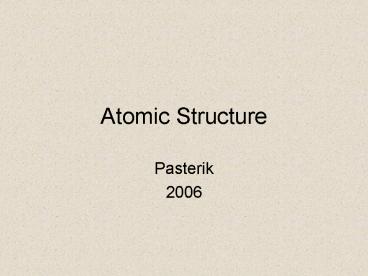Atomic Structure - PowerPoint PPT Presentation
1 / 17
Title:
Atomic Structure
Description:
A Bohr model of Beryllium. 4 protons. 4 electrons. 5 neutrons. Atomic Mass of 9. Electron Shells ... Electron cloud model of a Beryllium atom: 1. 2. The Bohr Model ... – PowerPoint PPT presentation
Number of Views:244
Avg rating:3.0/5.0
Title: Atomic Structure
1
Atomic Structure
- Pasterik
- 2006
2
Atoms
- What is an Atom?
- An atom is the smallest particle of an element.
Can an atom be separated into smaller parts? - Yes, they can be separated into
- electrons.
- protons.
- neutrons.
3
Electrons
- Electrons are very light negatively charged
particles. - Mass is almost insignificant relative to the mass
of a proton. - Surround the nucleus of an atom.
- Exist in orbitals or electron clouds called
shells. - Magnetically attracted to protons.
4
Protons
- Protons are positively charged atomic
particles found in the center, or nucleus, of the
atom. - Have an atomic mass of 1.
- All protons have the same mass.
- Exist in the nucleus (small central core) of the
atom. - Attracted to electrons magnetically.
5
Neutrons
- Neutrons are particles with no charge that
exist in the nucleus of atoms. - Have an atomic mass of 1.
- Atoms of the same element can have different
numbers of neutrons--those different atoms are
called isotopes.
6
Atomic Model (Bohr Model)
- A Bohr model of Helium
- 2 protons
- 2 electrons
- 2 neutrons
- Atomic mass of 4.0
7
Atomic Model (Bohr Model)
- A Bohr model of Lithium
- 3 protons
- 3 electrons
- 4 neutrons
- Atomic Mass of 7
8
Atomic Model (Bohr Model)
- A Bohr model of Beryllium
- 4 protons
- 4 electrons
- 5 neutrons
- Atomic Mass of 9
9
Electron Shells
- Electron Shells are the volume of space in an
atom where the electrons are likely to be. - the electron occurs randomly within the electron
shell. - Neils Bohr is credited for the initial
development of the electron shell concept. (Bohr
model, 1913). - only a certain number of electrons can fit into
each shell.
10
Electron Cloud Theory
- In 1928, the Electron Cloud Theory was
developed. (only minor changes). - Electron cloud is the volume of space around an
atomic nucleus in which electrons move. - motion of electrons is less definite than planet
orbits. - more like bees moving about the area around their
hive.
11
Electron Cloud Model
- Electron cloud model represents the possible
locations for the electrons at any time. - Electron cloud model of a Beryllium atom
12
The Bohr Model
- The Bohr model is still used to explain how the
electrons are distributed throughout the atom
into their shells. - Another term for shell is electron level.
- the first level can hold only two electrons,
- the second level can hold eight electrons, and
- the third level can hold up to eighteen, but for
our purposes we will say it can hold only eight
electrons.
13
The Nucleus
- contains almost all of the mass of the atom
- consists of nucleons
- (particles in the nucleus)
- protons
- neutrons
- The Atomic Number is the number of protons in the
nucleus of an atom.
14
Mass of the Atom
- Atomic Mass is the sum, expressed in a.m.u., of
the protons plus the neutrons in an atom. - electrons not counted in the mass
- 1,837 electrons 1 proton (mass)
- Atomic Mass Unit (amu) is a special unit of
measure used to express the mass of atomic
particles and atoms.
15
Atomic Mass Units
- Just how small is an atomic mass unit?
- There are 602 billion trillion atomic mass units
in a gram - 6.02 x 1023 a.m.u. in a gram or
- 602,000,000,000,000,000,000,000 a.m.u. in a gram
16
Drawing Bohr Models
- Draw a Bohr model atom for each of the first 20
elements. Do this in the form (same columns and
rows) of the periodic table given to you. Use
your periodic table to help you. - Hint remember that the atomic number is equal to
the number of protons the atomic mass minus the
atomic number equals the number of neutrons and
there will be the same number of electrons as
there are protons.
17
Bohr Models 1-20
1 2 13 14
15 16 17 18































